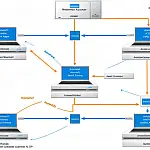Beginner's Guide To Scrum And Agile Project ManagementAre you looking to improve your project management process? Agile Scrum might be the solution for you. This guide will provide you with a step-by-step walkthrough of implementing Agile Scrum, helping you revolutionize your project management approach.
Scrum is an iterative and incremental agile software development method for managing software projects and product development. Scrum enables the creation of self-organising teams by encouraging the co-location of all team members, and verbal communication between all team members and disciplines in the project. Three distinct roles are identified within the Scrum methodology:
- The Scrum master, who ensures the process is followed, removes impediments and protects the Development Team from disruption
- The Product Owner, who represents the stakeholders and the business
- The Development Team, a cross-functional, self-organising team who do the actual analysis, design, implementation, testing, etc.
The development cycle of a software project is broken into time-boxed units which are called sprints. Common time frames for a sprint are a week or a month for larger projects. Every day within a sprint the progress of the project is evaluated.

Requirements for the final product are maintained in a list called the backlog (product backlog). In each sprint, one or more requirements will be implemented (sprint backlog) after which the next sprint is started.
Roles in Agile Scrum
One of the first steps in implementing Agile Scrum is to identify the different roles and responsibilities within the framework. The three main roles in Scrum are the Product Owner, the Scrum Master, and the Development Team. By clearly defining the roles and responsibilities of each team member, you can ensure that everyone understands their role in the Agile Scrum process and can work together effectively to achieve the project goals.
Product Owner
The Product Owner represents the voice of the customer and is accountable for ensuring that the team delivers value to the business. The Product Owner writes customer-centric items (typically user stories), prioritises them, and adds them to the product backlog. Scrum teams should have one Product Owner, and while they may also be a member of the development team, it is recommended that this role not be combined with that of Scrum Master.
Scrum Master
Scrum is facilitated by a Scrum Master who is accountable for removing impediments to the ability of the team to deliver the sprint goal/deliverables. The Scrum Master is not the team leader but acts as a buffer between the team and any distracting influences. The Scrum Master ensures that the Scrum process is used as intended. The Scrum Master is the enforcer of rules. A key part of the Scrum Master's role is to protect the Development Team and keep it focused on the tasks at hand.
Development Team
The Development Team is responsible for delivering potentially shippable product increments at the end of each Sprint. A Development Team is made up of people with cross-functional skills who do the actual work (analysis, design, development, test, technical communication, document, etc.). The Development Team in Scrum is self-organising.
Agile Scrum Sprints
A sprint is the basic unit of development in Scrum. Sprints last between one week and one month and are a "time-boxed" (i.e. restricted to a specific duration) effort of a constant length.
Each sprint is preceded by a planning meeting, where the tasks for the sprint are identified and an estimated commitment for the sprint goal is made and followed by a review or retrospective meeting, where the progress is reviewed and lessons for the next sprint are identified.
During each sprint, the team creates finished portions of a product. The set of features that go into a sprint comes from the product backlog, which is a prioritised list of requirements. Which backlog items go into the sprint is determined during the sprint planning meeting. During this meeting, the Product Owner informs the team of the items in the product backlog that he or she wants to be completed. The team then determines how much of this they can commit to complete during the next sprint, and records this in the sprint backlog. During a sprint, no one is allowed to change the sprint backlog, which means that the requirements are frozen for that sprint. Development is time-boxed such that the sprint must end on time; if requirements are not completed for any reason they are left out and returned to the product backlog. After a sprint is completed, the team demonstrates how to use the software.
A key principle of Scrum is its recognition that during a project the customers can change their minds about what they want and need and that unpredictable challenges cannot be easily addressed in a traditional predictive or planned manner. As such, Scrum adopts an empirical approach - accepting that the problem cannot be fully understood or defined, focusing instead on maximising the team's ability to deliver quickly and respond to emerging requirements.
Agile Scrum Meetings
Meetings are an important aspect of Agile Scrum. Meetings provide opportunities for collaboration and problem-solving, helping to ensure the success of the Agile Scrum implementation. By conducting daily stand-up meetings and sprint reviews, teams can stay organised, communicate effectively, and continuously improve their processes.
Daily Scrum Standup
Each day during the sprint, a project status meeting occurs. This is called a daily scrum, or the daily standup. The daily standup provides an opportunity for team members to share updates on their progress, discuss any challenges or obstacles they are facing, and plan their work for the next 24 hours. This helps to ensure that everyone is on the same page and working towards the same goals. This meeting has specific guidelines:
- The meeting starts precisely on time.
- All are welcome, but normally only the core roles speak
- The meeting length is set (timeboxed) to 10 minutes
- The meeting should happen at the same location and same time every day
- During the meeting, each team member answers three questions:
- What have you done since yesterday?
- What are you planning to do today?
- Any impediments/stumbling blocks?
It is the role of the Scrum Master to facilitate the resolution of these impediments, although the resolution should occur outside the Daily Scrum itself to keep it as short as possible.
Story Review Meeting
At the beginning of a sprint, a story review meeting is held in which the product owner runs through each of the stories he or she wants to be completed. This includes running through the requirements, and background information and allows the development team to ask any questions that they may have.
Story Planning Meeting
After the story review, a story planning meeting is held. This meeting is where the development team discusses each story, plans out the tasks and decides how long each task will take to complete.
The sprint planning meeting has specific guidelines:
- Meetings should not be longer than an hour
- Meeting does not include breaking stories into tasks
- The team can decide how many meetings are needed per week.
Sprint Retrospective
At the end of each sprint, a retrospective meeting should take place.
- All team members reflect on the past sprint
- Team members identify what went well and what could have gone better
- Make continuous process improvements
Scrum of Scrums
Each day normally after the Daily Scrum a Scrum of Scrums takes place. This meeting allows clusters of teams to discuss their work, focusing especially on areas of overlap and integration.
- A designated person from each team attends.
- The agenda will be the same as the Daily Scrum, plus the following four questions:
- What has your team done since we last met?
- What will your team do before we meet again?
- Is anything slowing your team down or getting in their way?
- Are you about to put something in another team's way?
Sprint Review Meeting
Sprint review meetings are held at the end of each sprint. During the sprint review meeting, the team demonstrates the completed work to stakeholders and gathers feedback. This feedback is then used to refine and prioritise the product backlog for the next sprint. Sprint reviews are important for ensuring that the team is delivering value to the customer and meeting their expectations.
Tips to Implement Agile Scrum in Your Team or Organization
Before implementing Agile Scrum in your team or organisation, it's important to have a clear understanding of the framework. The first step in implementing Agile Scrum is to set up the Scrum team and decide who will fulfil each role. The product owner should also define the product backlog by creating a series of user stories.
Once the Scrum team and product backlog are set up, the next step in implementing Agile Scrum is to plan and execute sprints. A sprint is a time-boxed period, usually between one to four weeks, during which the team works on a set of prioritised items from the product backlog. Decide how long each sprint should last. This is usually determined by the team size and how much work can be managed in a sprint.
During the sprint planning meeting, the team selects a set of items from the product backlog that they believe they can complete within the sprint. They break down these items into smaller, manageable tasks and estimate the effort required for each task.
Once the sprint plan is in place, the team starts working on the tasks. Daily scrum meetings are held to provide updates on progress, discuss any challenges or obstacles, and plan the work for the next 24 hours.
At the end of the sprint, the team holds a sprint review meeting to demonstrate the completed work to stakeholders and gather feedback. This feedback is then used to refine and prioritise the product backlog for the next sprint.
By following this iterative and incremental approach, Agile Scrum allows teams to deliver value to the customer early and frequently, while also allowing for flexibility and adaptation to changing requirements.







